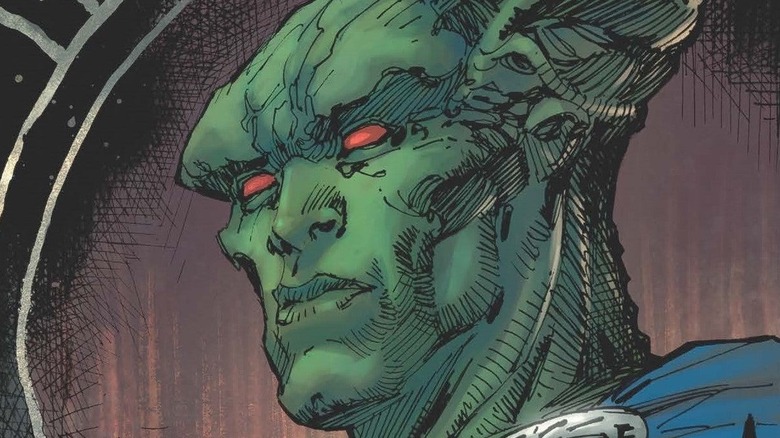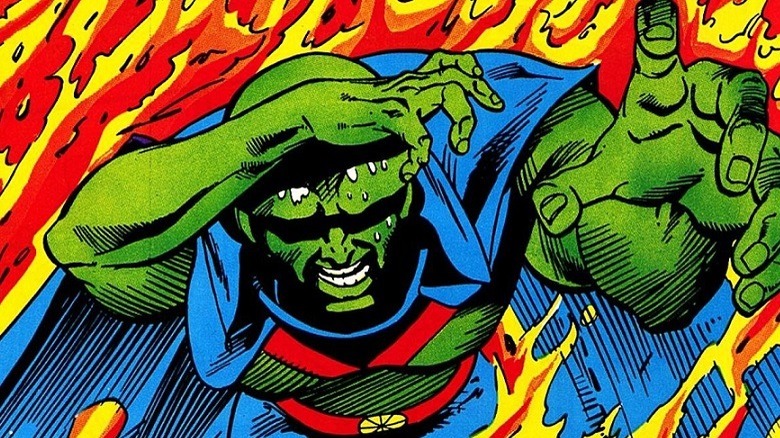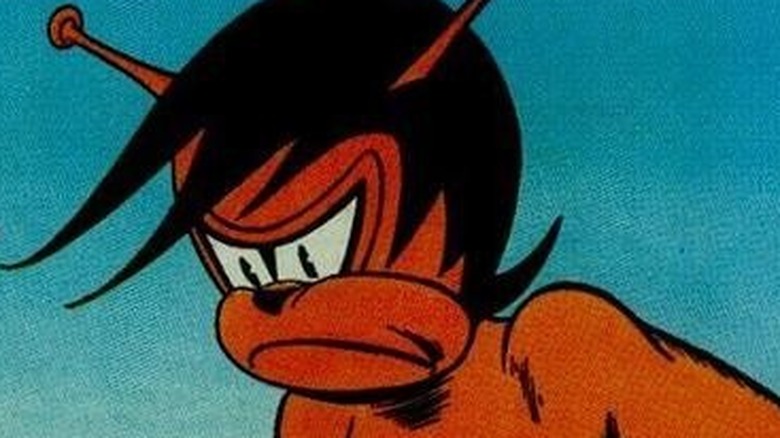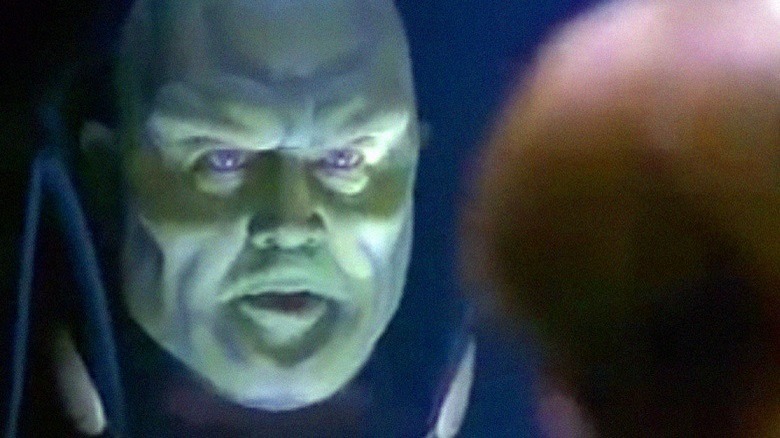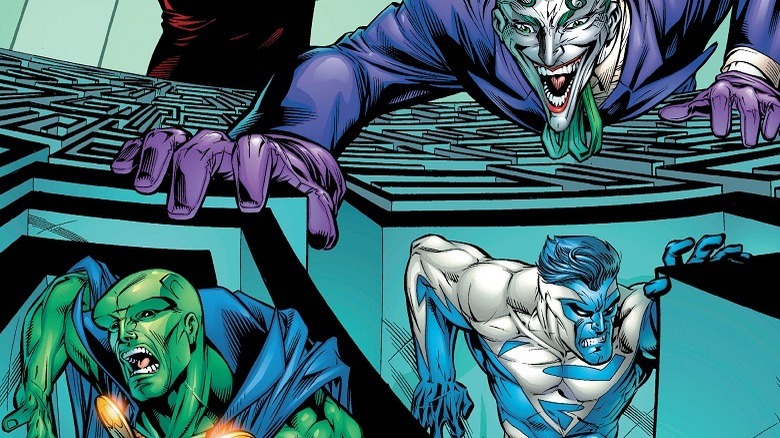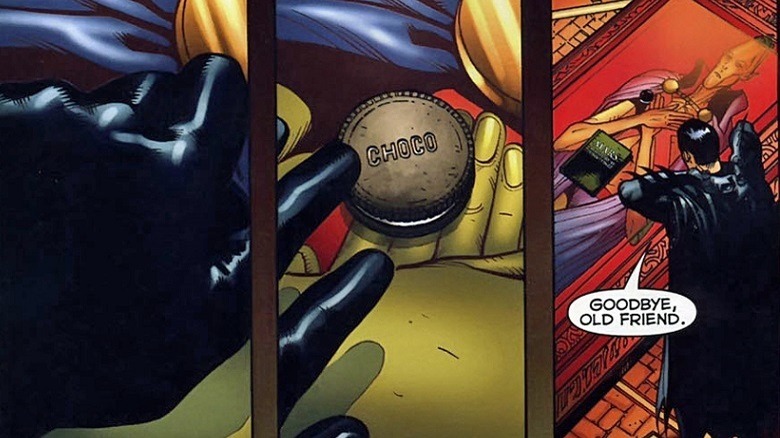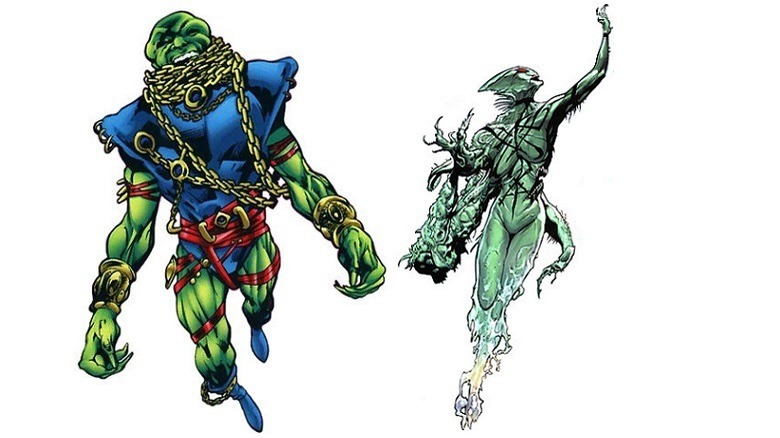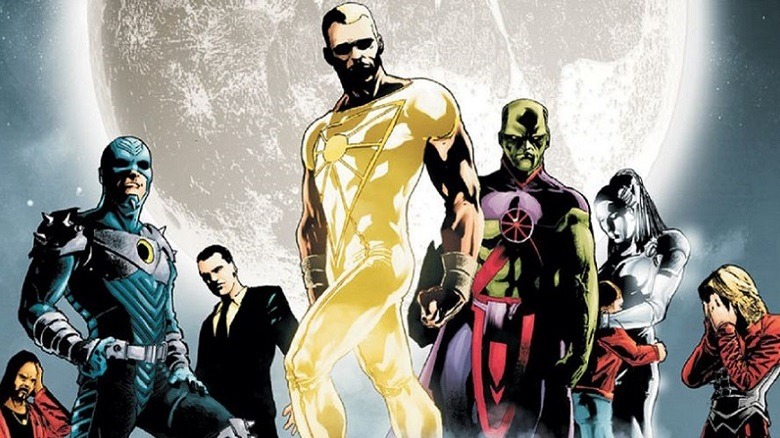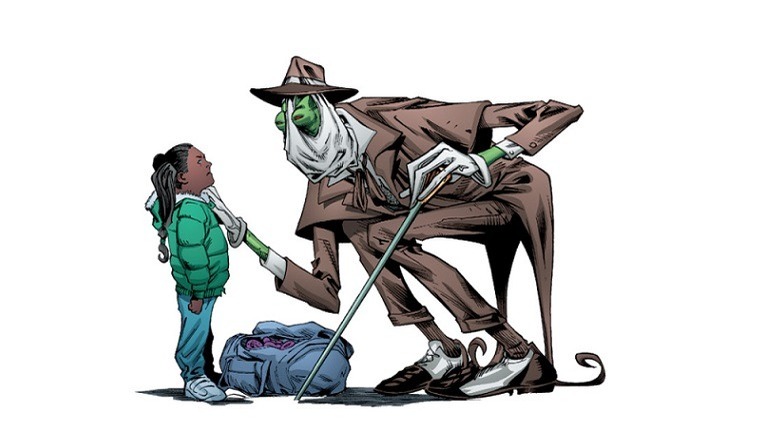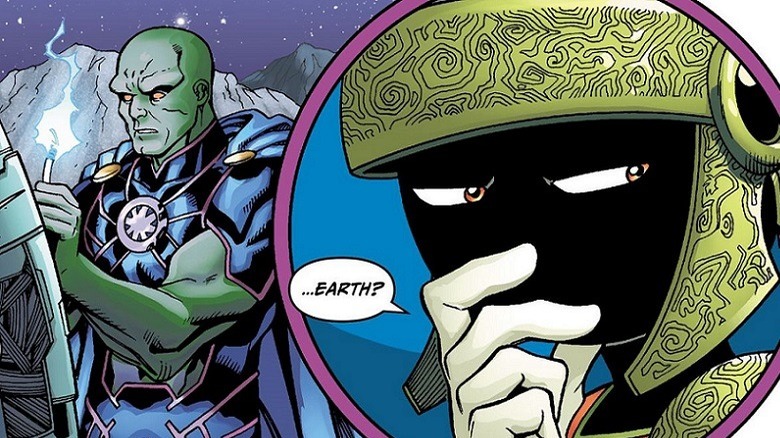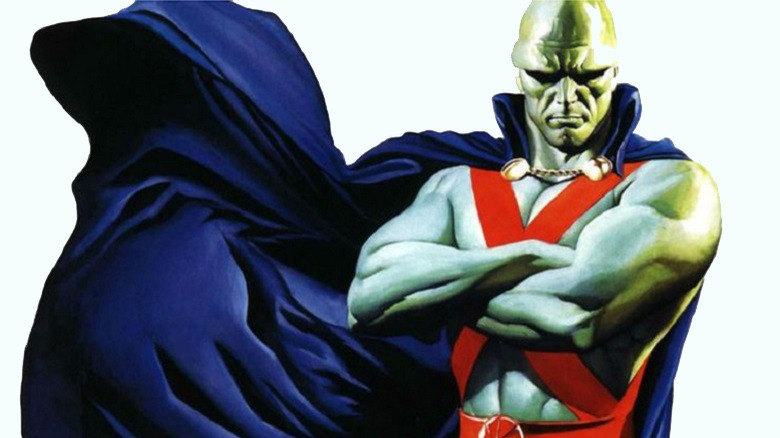10 Things You Didn't Know About Martian Manhunter
He's been gracing the pages of DC comics for seven decades, has appeared in multiple shows in the Arrowverse, where he's played by David Harewood, and even made a guest cameo in the closing moments of Snyder's four-hour cut of "Justice League." But who is the mysterious Martian Manhunter? What makes him tick? Why do chocolate sandwich cookies go mysteriously missing in his presence?
Created by writer Joseph Samachson and artist Joe Certa, the Martian Manhunter (real name: J'onn J'onzz) made his debut in 1955 in "Detective Comics" #225. He was brought to Earth by accident, caught in Doctor Erdel's experimental teleportation beam. With no way of returning home, the Martian Manhunter decided to fight crime (clearly the denizens of Mars are not keen on hobbies) whilst waiting for Martian technology to advance to a stage that could bring him back to his people.
J'onn J'onzz has often struggled to find a place in DC's comics, as his absurd power levels limit the number of tales in which he can be involved. To that end, despite his longevity, he's one of the lesser-known inhabitants of DC's formidable roster. So, in our search for the obscure, let's trawl the dark corners for 10 obscure facts about the cookie-devouring Emerald Enforcer...
The Martian Manhunter's weakness to fire is mental, not physical
In terms of sheer power levels, the Martian Manhunter is one of the most powerful beings in the DC Universe. Just look at all his abilities: shapeshifting, telepathy, flight, invisibility, nine — count 'em, nine — different senses, "Martian Vision," and the ability to phase through solid matter. He's gifted with the intellect of Batman and the physical prowess of Superman, and he's super-modest about it, too, although he struggles to fit that all into his Twitter profile.
So, what do you give the man — or, rather, the Martian — who has everything? The typical punchline, "penicillin," doesn't work here. What J'onn really needs is a weakness. Whereas Superman's vulnerability is kryptonite, that "rare" green crystal from his home world that crops up way too frequently, Martians are susceptible to fire, an altogether more commonly occurring phenomena.
This is no accident, but by design: the near omniscient galactic busybodies known as the Guardians of the Universe, terrified that the Martians would become superior to every other sentient race, programmed this genetic weakness of fire into them. J'onn would later go on to learn that the weakness to fire was not a physical limitation, but a mental one: when confronted with flame, the effect is psychosomatic, rendering the Martian vulnerable and powerless.
The Martian Manhunter used to have a partner called Zook
In the DC Universe, the fifth dimension is an inter-dimensional reality that exists outside the regular space-time continuum. It's the point of origin for several DC characters: Batmite, the bane of spell-checkers Mister Mxyzptlk, and the genie known as Thunderbolt. One lesser known fifth-dimensional entity is Zook, a creature encountered by the Martian Manhunter in 1963, who would later go on to become J'onn's crime-fighting partner.
Zook is a short orange humanoid with snail-like antennae who possesses almost as many powers as his malachite master. He has limited shapeshifting abilities, can alter the external temperature of his body to be boiling hot or freezing cold (handy if you want him to, say, regulate the warmth of the water in a paddling pool), and his antennae allow him to see through disguises.
Like much of DC's Silver Age output, Zook is now confined to the filing cabinet labelled "embarrassment" (see also: Angle Man, Stone Boy). He recently appeared as a villain in issue #28 of "Superman/Batman," in which he tried to kill the two eponymous heroes, but one suspects his longevity in the DC Universe is limited. Even with "The Suicide Squad" diving deep into DC's collection of misfits, don't expect to see Zook cropping up in the DCEU anytime soon.
The Martian Manhunter debuted on television around a quarter of a century ago
Modern audiences are spoiled by the quality of superhero material available on television and cinema screens. Once upon a time, however, we had to make do with the abhorrent Roger Corman "Fantastic Four" movie – which, thankfully, never saw the light of day outside of VHS bootlegs passed between collectors — and the "Justice League of America" TV movie from 1997, which gained notoriety for similar reasons (ie, it's very, very bad).
As J'onn J'onzz, David Ogden Stiers, a fine actor who portrayed Major Winchester in "M*A*S*H" and Timicin in the "Star Trek: The Next Generation" episode "Half a Life," can't hide his embarrassment, even under pounds of latex. In "Justice League of America," the proud Manhunter's importance to the Justice League (a league he founded, no less) is reduced to standing on the spot and mumbling exposition through tectonic plate layers of prosthetics. Not that anyone comes out of the "Justice League" pilot looking all that good, of course. In this shoestring production, the characters we've come to know and love are either powered down considerably or come across as whiny, childish, and spoiled.
The Manhunter has been portrayed on the big and small screen with more success since, but it's hard not to be disappointed by his grand debut. We can only hope that memories of it will eventually be lost in time, as the quality on the last bootleg tape fades.
The Martian Manhunter once cured the Joker's insanity
In the conclusion of Grant Morrison's epic "Rock of Ages" storyline, which ran from "JLA" #10 through #15, the JLA fought — and defeated — Darkseid in a future in which the tyrannical New God had taken control of a ruined and subservient Earth. Returning to the present time, they found their troubles were not yet ended. In their absence, the Crown Prince of Crime, the Joker, had gotten hold of the Worlogog, a powerful McGuffin that could rewrite reality to the bearer's will.
Obviously, this was bad news. The Earth began tearing itself apart as the Joker, ever creative, tried to carve a gigantic, continent-spanning grin across the world's surface. Despite their strength, the Justice League couldn't find a solution. They couldn't attack either the Joker or the Worlogog without risking reality being ripped wide open.
J'onn, resourceful as ever, had the solution. He telepathically rerouted the information entering the Joker's brain, forming order where there was chaos. "I'm making him sane," Martian Manhunter explained, "but I can't hold it for long. His mind is like a storm raging." The Joker, temporarily lucid, was guilt-stricken for the first time in an age, and handed the Worlogog back to the Justice League. It didn't last, and the tsunami of insanity flooded back into him — but it did last just long enough.
The Martian Manhunter once managed to bring out the Dark Knight's sensitive side
During the events of '08's "Final Crisis," Darkseid brought the supervillain Libra back to life and gave him a glorious new purpose. The previously second-string rogue threatened the entire Multiverse with his newly recruited army of villains, targeting Martian Manhunter in particular. See, with his formidable powers and ability to rally the Justice League, J'onn represented the single biggest threat to Darkseid's victory. For Darkseid to win, Martian Manhunter had to die.
In the end, J'onn was subdued by multiple attacks by a dozen villains, and while he nearly fooled his foes with a last, desperate psychic attack, his defense was ultimately for naught. As J'onn died, Vandal Savage's blade piercing his Martian heart, he sent out a final telepathic message to his colleagues, alerting them to his fate and passing on a virtual history of Mars and its last son.
The Martian Manhunter's violated body was later found and buried on Mars, placed in a pyramid taken from Egypt. As Superman delivered a touching eulogy to his deceased colleague, Batman, in a rare moment of sentimentality, placed a Choco cookie — one of Jonn's favorite snacks — onto the Martian's casket. Of course, very few superheroes stay dead for long, and like a jade Jesus the Martian Manhunter was resurrected: once as a zombie during the "Black Lantern" saga, and then later by the Entity, the living embodiment of the White Light of creation.
The Martian Manhunter isn't the only surviving Green Martian
At one point, Martian Manhunter believed that he was the only surviving Green Martian. It turned out that was far from the truth. For one, J'onn's brother Ma'alefa'ak (also known as Malefic) is still alive. A while back, Malefic had engineered an extinction-level event that had wiped out every Green Martian on the planet. This plague, known as H'ronmeer's Curse, makes any Martian who attempts to use their powers burn to death. Eventually, Malefic learned of Jonn's existence on Earth and pursued him in an attempt to complete his genocidal ambitions. He's been foiled on multiple occasions by both the Martian Manhunter and Justice League, but lives on as a continuing threat.
D'kay D'razz was another green Martian, bought to Earth in an experiment identical to the one that stranded J'onn on the planet. Unfortunately, D'kay was no hero. On Mars, she was a murderous scientist who was eventually imprisoned by her own kind for crimes against the red planet. Insane, she became obsessed with repopulating Mars, hoping to find the Martian Manhunter and make him her mate. J'onn eventually made her see the folly of her ways by throwing her into the Sun. Even on Mars, the path of true love never runs smooth.
The Martian Manhunter was once a member of Stormwatch. Or was he?
Debuting in a series of comics released by WildStorm in '93, Stormwatch was a covert team of superheroes tasked with defending the Earth from extra-terrestrial threats. In 2011, DC purchased the WIldStorm imprint, and relaunched the book, this time incorporating the characters in the main DC Universe. The Martian Manhunter was the only regular DC character on the new, revamped team, on which he was accompanied by WildStorm heroes like Apollo, Midnighter, and Jack Hawksmoor.
Eventually the team disbanded, faced with a different threat, as well as the knowledge that the Justice League of America had taken over their responsibility for intergalactic protection. Before Martian Manhunter went on to join the JLA, however, he used his telepathy to wipe his existence from the memory of all of his fellow StormWatch teammates. It's a move that marked the dawn of a new J'onn J'onzz, one much shrewder and more secretive.
The Martian Manhunter can, in dire peril, split himself into different people
In the Silver Age, the Martian Manhunter comic struggled with its identity. Often, J'onn was just used as a Superman replacement when the Man of Steel wasn't available. It wasn't until the '80s that J'onn began to really develop his own identity. Admittedly, much of his time in "Justice League" was spent being the straight man to his funnier teammates, but two standalone titles, "Martian Manhunter" and "American Secrets," began to flesh him out, expanding on Martian culture and establishing J'onn J'onzz's penchant for wearing multiple human disguises. Still, it wasn't until Grant Morrison's run on "JLA," which started in '96 and ran from issues #1 to #41, that the character took his rightful place as the founder — and heart — of the League.
In 2015, Rob Williams took a bold approach to our favorite Martian, one which treated him as truly alien. In Williams' the "Epiphany" storyline, the first arc of the latest "Martian Manhunter" comic, a group of White Martians tried to use J'onn as a weapon to conquer the world. Killing himself to prevent this happening, J'onn finds himself split into multiple people, each implanted with false memories to keep themselves hidden from the White Martians' leader, Ma'alefa'ak. The best — and oddest — of these is Mr. Biscuits. An 8-foot-tall, gangly, green-skinned humanoid named after J'onn's love for cookies, Mr. Biscuits is the personification of J'onn's subconscious. He's impulsive and prone to speak the second a thought enters his head. If a spin-off character ever deserved his own title, it's Mr. Biscuits.
The Martian Manhunter once fought Marvin the Martian
In a not-entirely-serious crossover that saw DC heroes meet Looney Toons characters — Catwoman helped Sylvester catch Tweety, for example, while Batman confronted Elmer Fudd in a surprisingly gritty story — the Martian Manhunter met another of his species: Marvin the Martian, the tyrannical would-be conqueror.
A character with a legacy even older than Martian Manhunter, Marvin the Martian burst into life in the 1948 Bugs Bunny cartoon "Haredevil Hare" as a bizarre creature with a jet-black bowling ball for a head and an outfit comprised of a Roman Centurion-style helmet and skirt. Hailing from the same red planet as J'onn, albeit one from elsewhere within the Multiverse, Marvin ("M'arvinn") had a simple aim: to destroy Earth with his trusty Illudium Q-36 Explosive Space Modulator, for no more profound reason than that our dratted planet obscured his view of Venus. In the comic, the Martian Manhunter had to convince his pint-sized parallel that humanity shouldn't be destroyed. Marvin countered by arguing that mankind has done nothing but try to blow him up.
At the very end of the DC Universe, the Martian Manhunter became the planet Mars
In the winter of '98, DC's big event was "DC One Million," a story set in the far-flung 853rd century that showed what happened to the descendants of DC's beloved characters. We'd just met the far-future version of the Justice League, the Justice Legion Alpha, in the pages of "JLA" (Issue #23), which acted as an introduction to this ambitious, multi-comic arc.
"DC One Million" revealed that J'onn's fate was to wander the stars, continuing to protect the innocent while searching for meaning. Eventually returning to Earth, the Martian Manhunter led humanity against a terrible foe: the planet-stripping hivemind known as the Swarm. He proved victorious, and returned home to Mars to rest.
However, his tranquility was short-lived. Darkseid sought to transform Mars into a new Apokolips, and so drew J'onn into a final battle, during which both combatants plummeted to their end into the Source, the endless energy field from where all life emerged. Still, J'onn got a happy ending. He was rewarded by the Source, which merged his atoms with those of his home planet. J'onn literally became Mars, a sentient world that was now thriving with life — a fitting and dignified end for our displaced hero.
